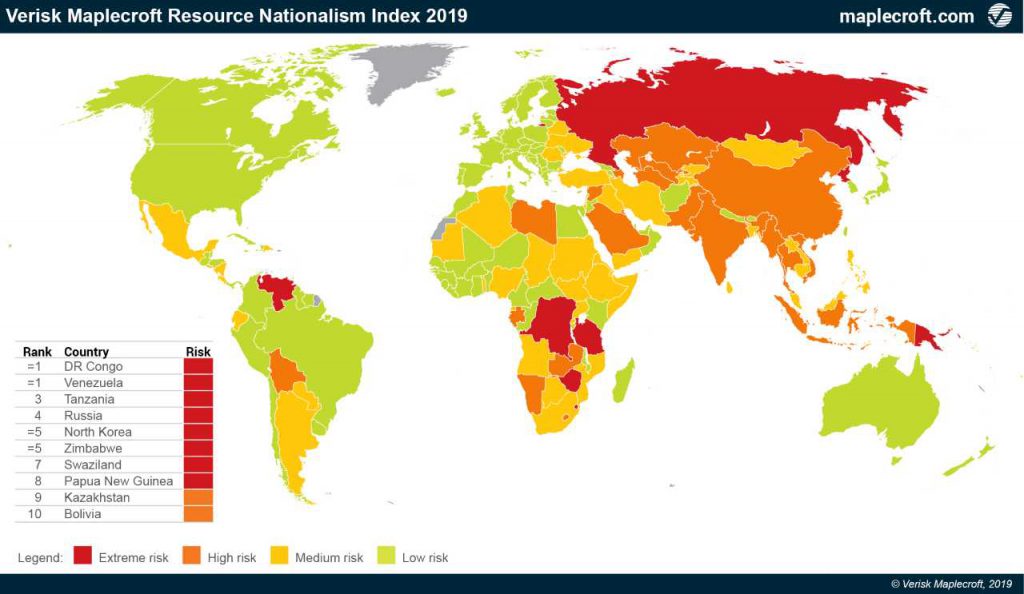According to global risk consultancy Verisk Maplecroft’s latest Resource Nationalism Index (RNI) report, a total of 30 countries have registered a significant increase in resource nationalism risk metrics over the past year, 21 of which are considered major producers of oil, gas and minerals.
The RNI is aimed to measure the risk of expropriation, the imposition of more stringent fiscal regimes, and the pressure for companies to source goods and services from local providers. Countries are also rated and ranked based on these risk metrics.

Specifically, the RNI report names Russia and the Democratic Republic of Congo (DRC) as the two notable movers on the list, with both being downgraded to ‘extreme risk’ to indicate that the risk of governments taking greater control of natural resources is the highest. In DRC’s case, the risk bump was mostly a byproduct of its new Mining Code, which allowed more government interventions and oppressive fiscal terms for existing operators. Eight countries now have the ‘extreme risk’ rating (starting from highest risk): Venezuela, DRC, Tanzania, Russia, North Korea, Zimbabwe, Swaziland and Papua New Guinea.
Although outright expropriation has become a less likely scenario than before, government measures such as tax pressures, changing contractual terms and strict regulations can still make countries difficult to operate in.
Africa has long been recognized as a high-risk jurisdiction. It has gotten worse over the past year as 10 nations experienced growth in risk factors, according the RNI report. Other countries such as Mexico, India, Malaysia, Turkey and Iraq also saw increased risks as governments took measures to erode the revenues of operators.
On the upside, the RNI report shows that 24 nations have seen improvements in their index performance, including Zimbabwe (joint 5th), Vietnam (25th), Ecuador (46th) and Guinea (94th). Even though Zimbabwe is still far away from what is considered a stable mining destination, its score has improved thanks to a new government regime that has been actively encouraging foreign investment. The country boasts the world’s second largest platinum and chromium reserves, according to Verisk Maplecroft, and could attract meaningful investment from abroad and even shed its ‘extreme risk’ tag.
Ecuador has made more significant progress. Since President Lenín Moreno came to power in 2017, Ecuador has jumped from ranking 3rd and ‘extreme risk’ in the Resource Nationalism Index two years ago to 46th and ‘medium risk’ in 2019.
Read the full report here.
2 Comments
slvrizgold
Oh, I see. The places that you can’t do business are places with jackboot dictatorships, low-IQ retards, and socialist idiots that live in perpetual poverty courtesy of the government. That was easy to figure out.
Alberta Doc
It’s interesting that no one ever mentions the environmental risks and liabilities that have resulted in, “low risk” countries, such as Canada. Lax rules and enforcement, has allowed miners and drillers to not address the cost of clean up. We now have as much as $260 billion in liability for cleaning up the Alberta energy sector in Canada, and our governments are terrified to admit it. This kind of news could sink the energy sector and Canada’s economy with it. All this while the public coffers lose dollars, because the royalty formula favours industry. This doesn’t include other energy producing provinces, who are experiencing similar situations. Unfortunately, Canada’s “low risk” rating, comes with a much steeper price, then most Canadians are prepared to accept as reasonable.